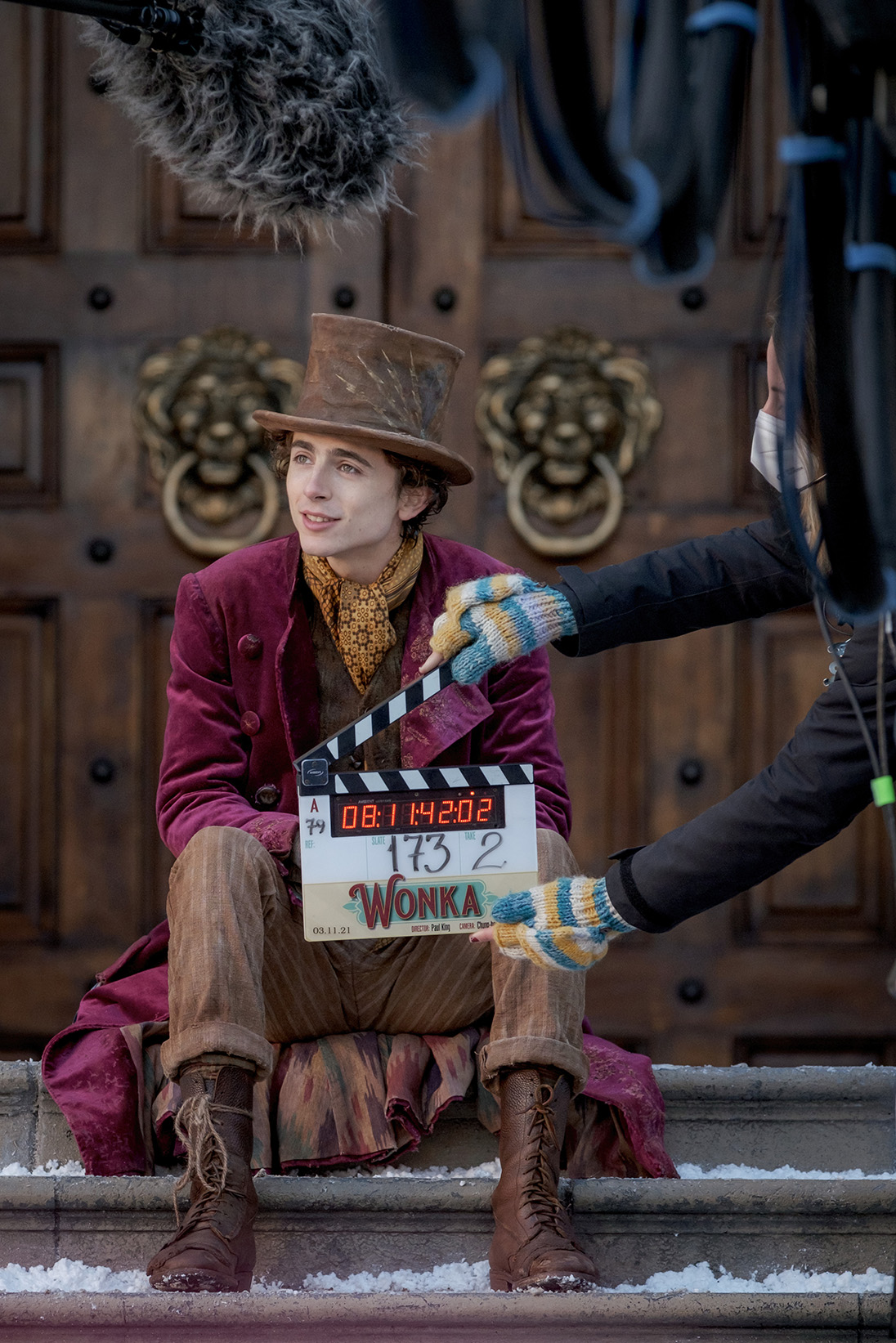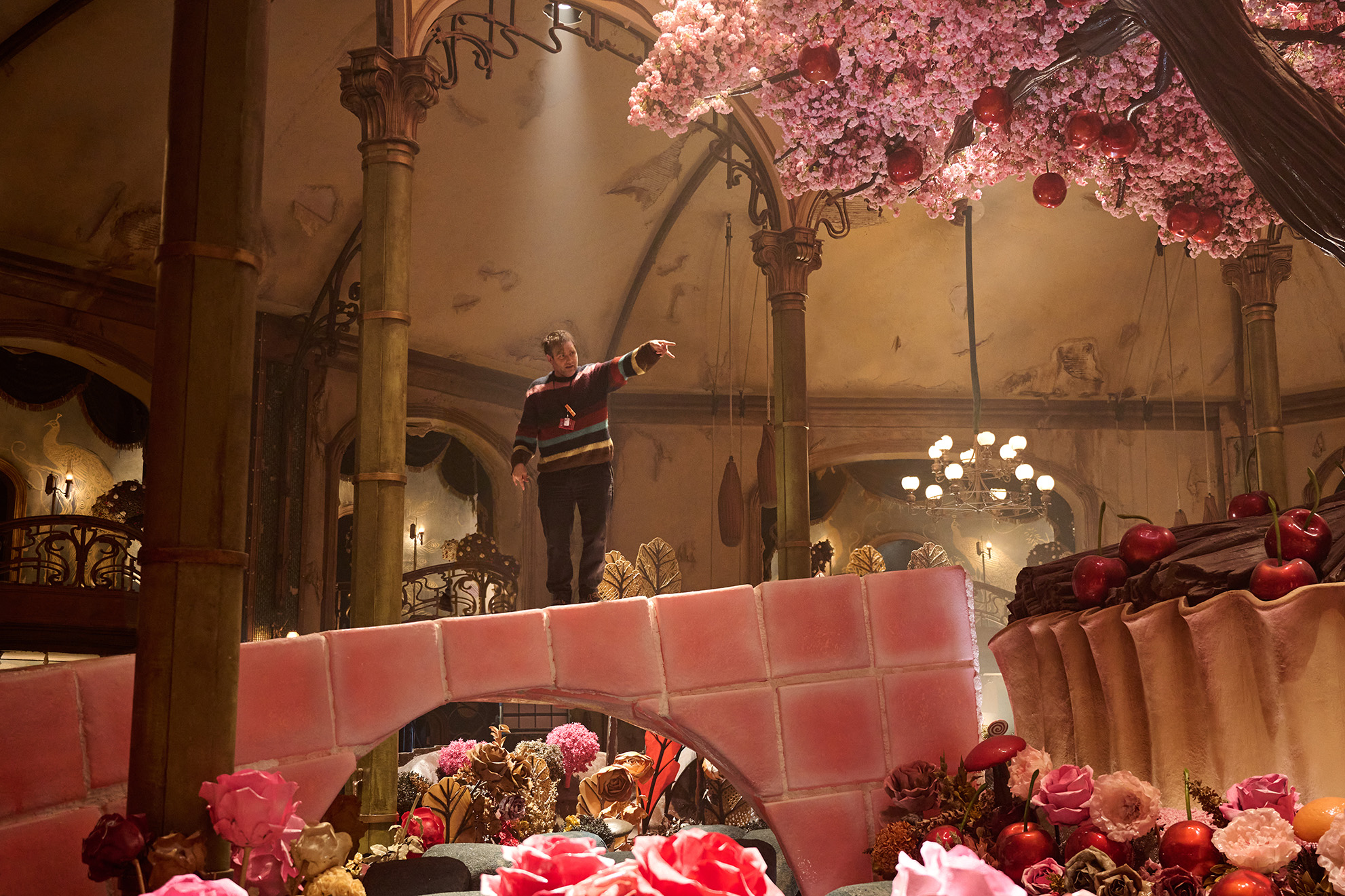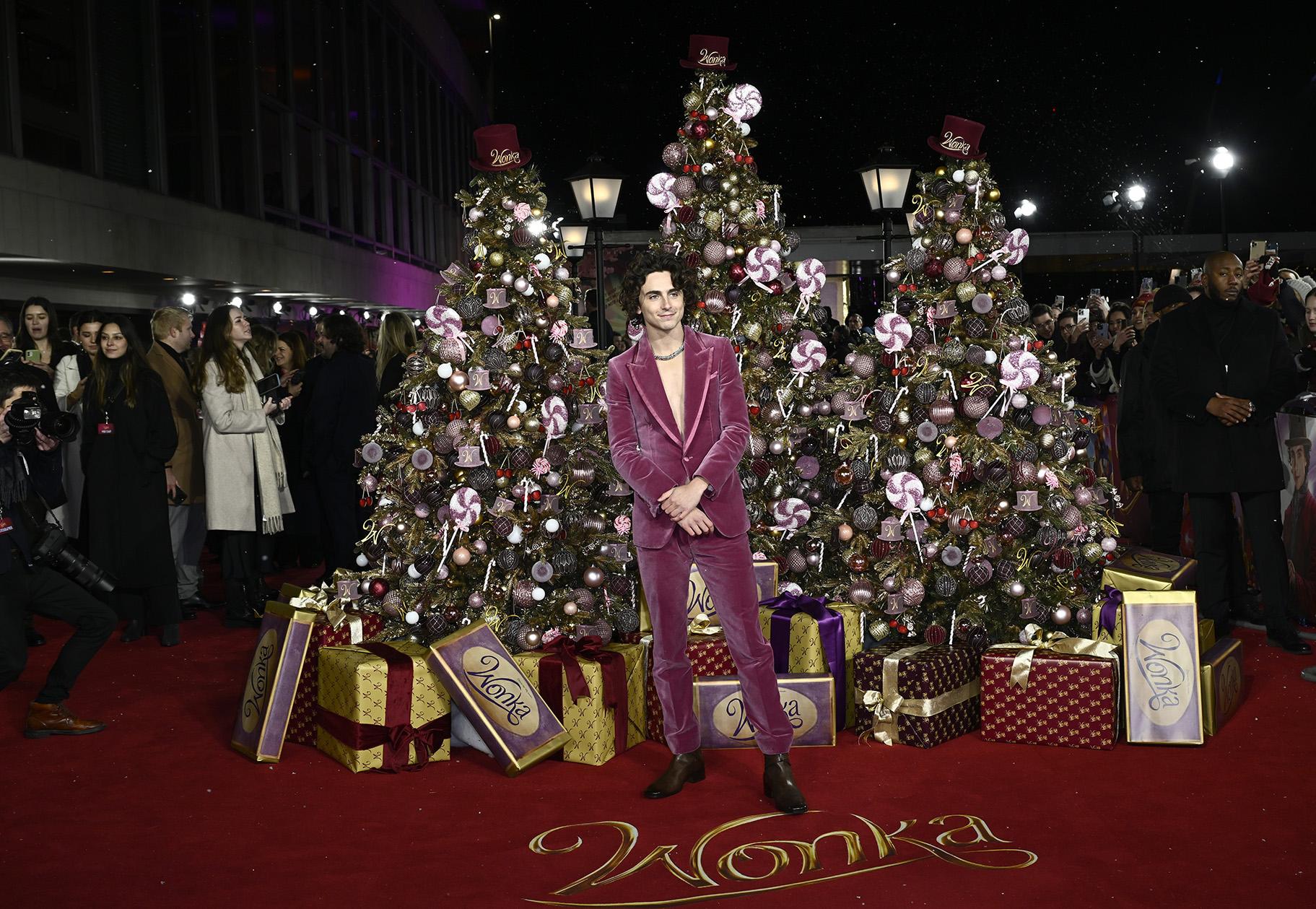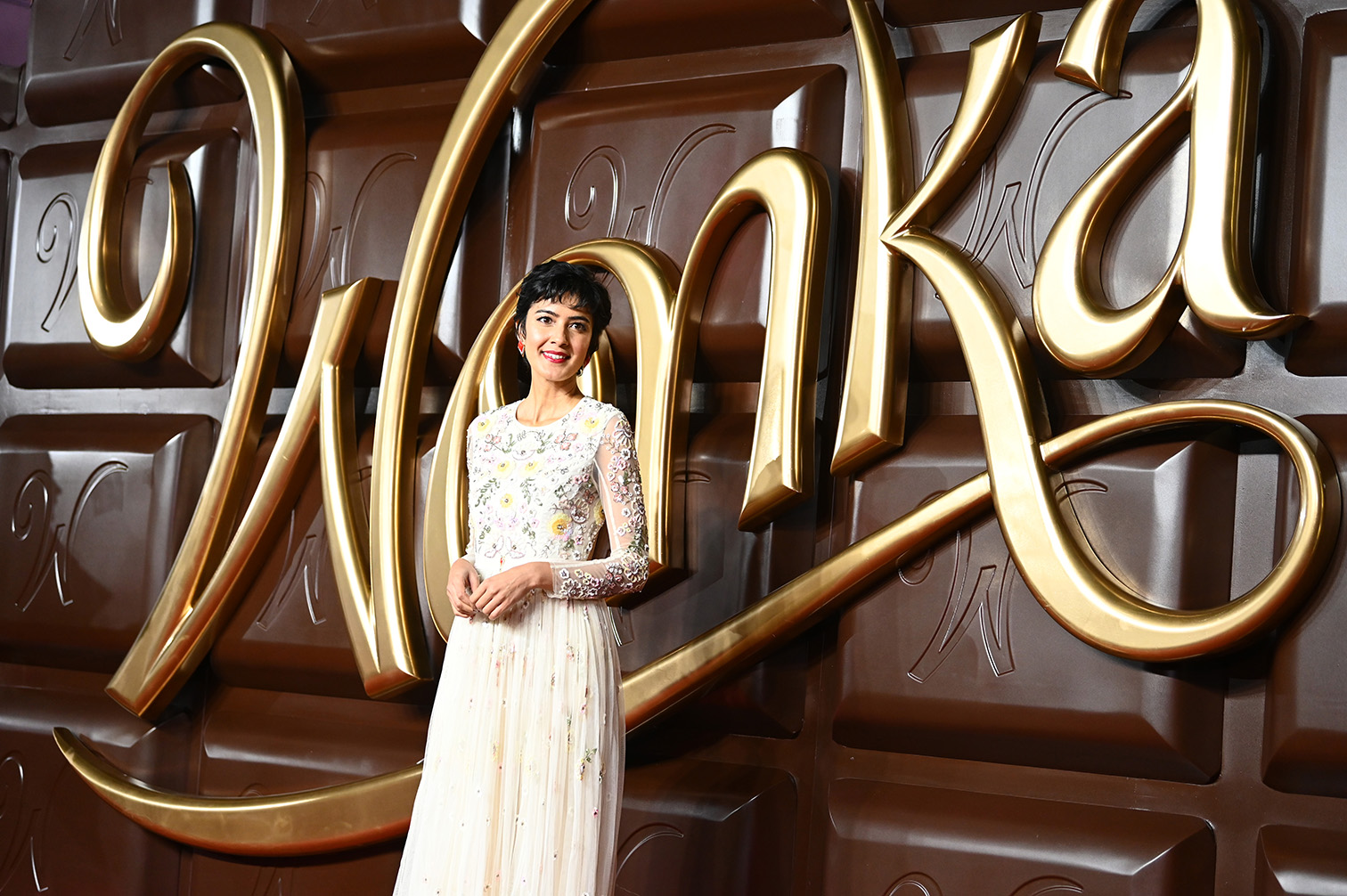The movie “Wonka” is based on the beloved character from Roald Dahl’s “Charlie and the Chocolate Factory.” It’s a captivating tale about a young chocolate-maker, Willy Wonka, who dreams big and transforms the world one delicious bite at a time. Directed by Paul King and produced by David Heyman, the film stars Timothée Chalamet in the lead role.
Filming started at Warner Bros. Studios Leavesden in fall 2021 and spanned 21 weeks across more than 50 sets in three sound stages, a backlot, an aircraft hangar, and various locations. The production included Main Unit shooting and a dedicated “Oompa Loompa Unit” for specific scenes.

To bring Paul King’s vision to life, the creative team crafted a fairytale city on the Leavesden backlot and adapted locations around England. The city, described as the “best of Europe” by King, featured a blend of architectural styles from Belgian, Czech, Dutch, French, German, and Swiss influences.
The meticulous design, overseen by production designer Nathan Crowley, extended to the smallest details, creating an island city with a ruined castle, ornate town square, cathedral, and the famed Galeries Gourmet. Cobbled streets led to docks, bridges, and alleys, while underground streets revealed secret paths where Wonka peddled his chocolates.
Despite space limitations in soundstages, the team used traditional techniques, such as back-lit painted backings and mirrors, to expand perspectives. The resulting blend of real-world structures, set builds, and locations enhanced the romantic and fantastical atmosphere, creating a world where Wonka’s magic comes to life.
Building the Town Square, covering a massive 900m x 900m space on Leavesden’s largest backlot, took nearly eight months. Inspired by Prague’s Old Town Bridge Tower, Crowley created an enchanting entrance. The cathedral’s design merged St. Paul’s and Prague church influences. Filming inside the Cathedral required a rare three-day closure of St. Paul’s, with special permission to open the Great West Door.

The square boasted 12 functional shops, two restaurants, two outdoor dining areas, a food market, and a florist, each with its unique style. Sandales curated items from markets, antique firms, and rental companies in the UK and Europe. A practical fountain at the square’s center transformed into a winter scene with artificial snow, managed by special effects.
Behind grand iron gates across from the cathedral, Galeries Gourmet housed the Chocolate Cartel shops and other upscale merchants. Drawing inspiration from neo-Renaissance architecture, Crowley fashioned a glass-domed arcade with an octagonal intersection. Slugworth, Fickelgruber, and Prodnose were visually identified by signature colors in their costumes and graphics.
Grand shop windows showcased chocolates with distinct designs: a navy-blue Victorian gothic design for Slugworth, a green Art Deco-inspired print for Fickelgruber, and a yellow 1940s geometric print for Prodnose. Other windows displayed gourmet items like cheeses, caviar, and wines, adorned with bespoke velvet drapery, marble walls, and an elaborate mosaic floor.
To accommodate the flying action of the Hoverchoc sequence, a temporary stage was constructed on the backlot adjacent to the town square, providing a geographically accurate set at 45m x 45m and 25m high.
The interior of Wonka’s Chocolate Shop, a distinct build on Leavesden’s S Stage, embodied Dahl-inspired design. A romantic and enchanted candy land, it featured moving, rotating theatrical elements that brought extraordinary imagination to life.
Designed based on Willy’s childhood memories, the shop’s centerpiece was a cherry blossom tree, reaching a rotating top surrounded by pink-tinged cotton-candy clouds. A chocolate barge sailed along a candy river with white- and cream-topped theatrical blue waves. A pink Turkish Delight-road wound around the shop, and everything in the magical garden was meant to be edible.
Extensive research and development ensured that artificial flowers and greenery looked truly edible, employing techniques like sculpting, test painting, sugar coating, glazing, and chocolate dipping. The set followed a simple rule: if it didn’t look edible, it wasn’t used.
The entirety of Scrubitt & Bleacher came to life on Leavesden’s F Stage, featuring the shop’s lobby, the wash house, Willy’s room, Noodle’s room, connected by corridors, circular staircases, chutes, dumbwaiters, and the infamous coop. Shiny reflective tiling illuminated the wash house basement, densely adorned with various laundry devices, including enormous copper vats, a large mangle, irons, ironing boards, baskets, basins, and buckets.
A notable addition was a Rube Goldberg-type contraption devised by Willy, featuring a chain reaction powered by dogs.

Constructed on Leavesden’s I Stage, the concealed vault comprised sets like the vault control room, chocolate tank, confessional booth access, secret elevator, and vault corridor. The Crypt itself featured an ornate Art Deco- and Russian-inspired design. Pipes, valves, and gauges adorned the walls, resembling a high-tech machine room. The room was furnished like a grand gentleman’s club, complete with a bar, chocolate machines, camelback sofas, wingback chairs, and 1930s-inspired chandeliers. At one end, a small submarine-style door secured with a wheel allowed access to the chocolate tank—a tiled tank resembling a pool of melted chocolate.
Gabriella Cugno, a real-life chocolatier on the set decorating and props team, played a crucial role in creating the chocolates for the film. King selected his favorites from Cugno’s initial creations, and she collaborated with the props team to design molds for Willy’s portable chocolate-making case. The chocolates, including 900 Hoverchocs, 80 Silver Linings, 85 Big Night Outs, 150 Giraffe Milk Macaroons, 400 Forty Second Sweets, 200 Hair Repair Éclairs, and 80 Mamma’s Wonka Bars, were all hand-tempered and handmade, with natural ingredients and no artificial flavors or preservatives.

Cugno also crafted limited editions of edible flora for the Wonka’s Chocolate Shop sequence, including blue ball flowers, purple flowers, red roses, and the famous last-minute chocolate teacups. Other edible confections included purple and orange mushrooms, purple roses, large orange leaves, cherries, cherry blossoms, soil, honeycomb, bees, pears, tree bark, doughnuts, ice creams, and a sweet version of spaghetti and meatballs. In addition, she created around 400 conventional chocolates for the Cartel.
Every chocolate crafted for “Wonka” reflected Willy Wonka’s pride—completely hand-tempered and handmade, using all-natural ingredients without artificial flavors or preservatives.
Designing for “Wonka,” an enchanting origin story with music, allowed Nathan Crowley to delve into pure fantasy, departing from his usual approach to film design. As a designer, his aim was to seamlessly immerse the audience in the world without causing distraction. Fantasy granted him the freedom to be more creative and experimental, creating a whimsical yet believable world. The film’s setting, a fictional city infused with elements from various European cities, transforms into a magical place under Willy Wonka’s influence. Crowley aimed to craft a visually unique and unforgettable journey for the audience.
Paul’s vivid descriptions and experimental ideas during pre-production guided the design process. Initially considering filming in Europe, the team explored real town squares, but logistical challenges led them to construct a vast backlot, allowing them to claim the space as their own.
Lindy Hemming, the costume designer, also discussed the intricate details behind Willy Wonka’s costumes. The fundamental concept was that Wonka had traveled the world in these clothes, adapting to various climates. The film introduces him in ship attire—trousers and a shirt—signifying his recent arrival. Putting on layers becomes a symbolic part of his journey ashore, with the burgundy velvet coat marking the transition to Gene Wilder’s iconic Wonka world.

For the chocolatiers’ costumes, tailored wools had to be dyed to specific colors, aligning with Paul’s vision of one green, one blue, and one yellow. This color scheme extended to their chocolate shop, wrappers, and overall aesthetic, creating a coordinated visual theme. The decision to embrace vibrant colors signaled a heightened reality, with broad characterizations.
Attention to detail extended to Olivia Colman’s character, Mrs. Scrubitt. Every piece of her wardrobe, from printed aprons to knitted cardigans and constructed dresses, was carefully crafted. Even seemingly casual items like her overalls had a meticulously designed backstory, enhancing the overall storytelling through costume choices. The commitment to detail ensured that each element of the characters’ clothing contributed to the rich narrative tapestry of “Wonka.”

In conclusion, the behind-the-scenes journey of crafting Willy Wonka’s enchanting world unfolds as a tale of creativity, collaboration, and meticulous attention to detail. From Nathan Crowley’s visionary set designs that seamlessly blend fantasy with believability to Lindy Hemming’s intricate costume choices that breathe life into each character, the production of “Wonka” stands as a testament to the artistry and dedication that go into bringing a beloved story to the silver screen. The construction of elaborate sets, the inventive chocolate creations by Gabriella Cugno, and the decision to embrace vibrant colors all contribute to the cinematic alchemy that makes this production a visual feast. As we anticipate the film’s release, the behind-the-scenes insights into the making of Willy Wonka promise an extraordinary and unforgettable cinematic experience.
Discover more from SNAP TASTE
Subscribe to get the latest posts sent to your email.



